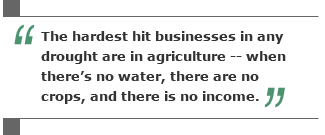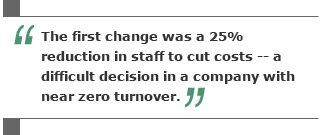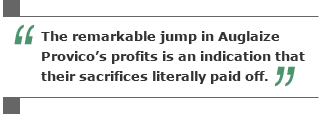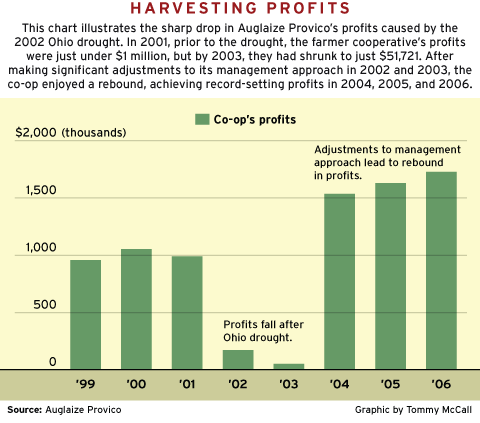In retrospect, catastrophes are rarely unexpected. There's almost always advance notice that something awful is coming, and leaders are responsible for scanning the horizon to watch for the warning signals. The ability to evaluate those signals and anticipate the consequences is one of the things that distinguishes good leadership.
 |
When competent leaders see disaster coming their way, they take preemptive action, marshal their forces to deal with the likely effects, then dig in to repair the damage. So do great leaders. But somehow, great leaders manage to do those things in such a way that their organization winds up in better shape than it was before the tempest touched down. These kinds of leaders are scarce, and one has to search both history and business journalism to find even a handful. But one model of brilliant leadership in the face of total disaster can be found in, of all places, the small community of Wapakoneta, Ohio.
Drying up
Wapakoneta, population 9,474, is in the middle of "flyover country." But the disaster that befell it and the rest of the Midwest was of passionate interest to the people who live there. In 2002, while most people in the United States had their eyes on the Middle East, part of Middle America was experiencing drought on a scale not seen in years. The drought threatened to destroy businesses, small-town economies, and individual lives.
The hardest hit businesses in any drought are those involved in agriculture -- when there's no water, there are no crops, and there is no income. Small farms are often the first businesses to die, and second are the companies that sell agricultural products. In Wapakoneta, that company is Auglaize Provico, a farmer cooperative (more commonly called a "co-op") that buys and markets grain and sells petroleum products, livestock, farm supplies, fertilizer, seed, and spray materials.
Corn-belt co-ops were first established more than a century ago, and their structure hasn't changed much. Most are owned by farmer-members, governed by a board of elected member-directors, and meant to be non-profit -- in that profits are returned to members as cash or a greater stake in the co-op. Like many farm community co-ops, Auglaize Provico is a leading local employer, with 135 employees in 14 small towns.
Larry Hammond is the CEO of Auglaize Provico. His co-op had endured damaging weather patterns for a couple years, but when the drought intensified in the spring of 2002, he knew that the worst was just beginning. Even his most dire fears, however, were too optimistic. Auglaize projected up to a 60% decrease in grain volume due to the drought, which accounts for half of its revenue; it turned out to be 70%. By the end of the disastrous 2002 harvest, the co-op was down about $4 million in margins and service income. For a small company in a small town, a loss like that is more than devastating. It's final. But Hammond's co-op survived, and for the next three years, posted record profits.
So how did a small co-op, a remnant of 19th-century farming, turn calamity into victory -- something global mega-companies and trillion-dollar governments fail to do all the time? Actually, it wasn't all that complicated -- just incredibly hard.
The tough decisions
Before 2002, Larry Hammond had a managerial style that CEOs really shouldn't emulate. It was essentially this: Everyone and everything went to Larry. "He would operate [Auglaize Provico] almost on a paternal basis," says Barry Conchie, a Gallup leadership consultant. "Larry used to do pretty much everything." Hammond was successful because the co-op only had 160 employees at the time and because he is deeply committed to the well-being of each one of them. You can do everything if you know everybody. This style creates inefficiencies, however, and when disaster hit, Auglaize couldn't afford any weak spots.
"When we saw that the drought was getting worse, I called forty of our key people together and said, 'Guys, we have to change the model of this business,'" says Hammond. The first change was a 25% reduction in staff to cut costs -- a difficult decision in a company with near zero turnover. The reduction was handled extremely carefully, though: Some reduction in staff occurred from the resignations of part-timers and seasonal help, some near-retirees opted out early, and the rest were assisted into other jobs.
"[At the time], we had to have transparency and be honest about what we needed to do and what was going to occur," says Mike Dammeyer, a division manager at Auglaize Provico. "It may not have always been popular -- it surely wasn't what management in any phase wanted to do -- but it was what we had to do. And it went over surprisingly well."
Grain elevators were sold, and the co-op took on work outside its previous core business. Hammond asked the CFO to cut his pay as CEO, though no one knew about it at the time. "It was for me psychologically. I wasn't trying to be a martyr, but I needed to know that I was making a sacrifice, just like everyone else," says Hammond.
The biggest change was recreating the co-op's leadership structure. Instead of everything winding up on Hammond's desk, Auglaize moved to a more executive-based leadership style. Managers were given responsibilities they never had before, though they probably should have. Nonetheless, Hammond was still making the toughest decisions -- the ones that people in 14 Ohio towns were watching closely.
"There were a lot of hard decisions to be made," says Hammond. "I said 'Guys, I'm going to take charge of this. If someone has a problem, they need to come to me. This is a part of us pulling together, believing and working together.'"
 |
Under normal circumstances, Hammond's changes would have paid off in years of increased productivity. But these weren't normal circumstances. Crops were drying up and blowing away. Staff members were nervous, and they were doing more with fewer people. The co-op's market area was anxious and aware that a lot of farmers weren't going to make it.
Hammond was forced to make difficult choices, put himself in the line of fire, and do anything he could to see his business through a bad time. That's what good leaders do. But what makes Hammond a great leader is what he did next.
The difference
In 2002, Hammond decided to go to graduate school to obtain an MBA. Given the severity of the drought, a lot of people in farm country were wondering how many businesses would be left to manage by the next harvest, and the 125 remaining Auglaize Provico employees were justifiably worried. Looking back, Hammond's decision to start graduate school seems, to be blunt, reckless -- but it was inspired.
All the changes, all the pressure, and all the worry proved to Hammond that his instinct as a manager was right. "It's about people," he says. "Managing the business is not doing the business. It's positioning the people. It's driving the culture. It's developing the initiatives. I needed to know more about managing people and my own strengths."
Hammond had attended some Gallup-sponsored summits and meetings and had read one of the organization's management books, First, Break All the Rules. So his decision to enroll in Gallup's MBA program had been a long time coming and was well-considered. Still, he was in for some surprises.
"I felt like I was a sparrow with a bunch of eagles," says Hammond. "I was in [the program] with executives like George Borst [President and CEO of Toyota Financial Services] and Rob Webb [now Head, Global Service Delivery, Citigroup Employee Services] -- guys in charge of thousands of employees. But never once did I feel like I was inadequate. Business philosophy and dealing with people are the same, no matter how many employees you have."
However, dealing with people as though they are all the same is a mistake, Hammond learned. In fact, he was so intrigued with what he was learning that long before he completed his degree, he asked Conchie, one of his instructors, to go to Ohio to implement strengths-based development, starting with the executive leadership team at the co-op. And that's what proved to make all the difference.
The strengths approach
Everyone has different talents -- natural patterns of thought, feeling, and behavior. By recognizing and building on those talents with pertinent skills and knowledge, they create strengths -- the ability to consistently provide nearly perfect performance in certain tasks. Strengths are powerful; people who are applying a true strength are at the top of their game. And in organizations that take a strengths-based approach to managing their employees -- that encourage employees to leverage their innate talents -- employees can make strong contributions that drive the business forward.
The strengths philosophy was new to Auglaize's management. "They used a 'deficit' approach," says Conchie. "They spent a lot of time identifying their weaknesses and trying to work out what they should be doing to correct them. So a lot of Auglaize's management was relatively negative." That's not uncommon in any organization. But Hammond wanted to change that approach.
"If you really want to [excel], you have to know yourself -- you have to know what you're good at, and you have to know what you're not so good at," says Hammond. "And a lot of people don't. Most of us know what we're not good at because people tell us. And we also tend to want to fix it." The idea that workers should "fix" their weaknesses is endemic in American business, and it's a problem because attempts to fix weaknesses take time, attention, and energy away from maximizing naturally powerful talents.
In 2002, Auglaize Provico didn't have time or energy to waste. That's why Hammond's decision to undertake a graduate degree is, in retrospect, one of the best decisions he made for his company.
Long before Hammond graduated, Conchie was working with the CEO's employees in Ohio. "Every single employee in the organization took the Clifton StrengthsFinder [an assessment that measures a person's talents in 34 categories, referred to as "themes," then reveals the user's top five themes] and has had an individual strengths consultation at least twice," says Conchie. "I've run a number of family sessions in the evening around strengths so that spouses and kids can get involved. The board is involved. Strengths have been totally ingrained into their entire organization."
 |
This strengths-based management approach helps employees build on what they naturally do best. And they are more productive, their customers are better served, and the organization is more successful. "I think StrengthsFinder creates a focus," says Dammeyer. "It educates you about your people, and any time you have a higher degree of understanding -- especially when it comes to relationships and people because that affects performance and sales all the way down the line -- it will lead to better outcomes."
Memories of the past
In 2002, no one at Auglaize expected a positive outcome. And at that time, they were right. The co-op's profit in 2003, which reflects the 2002 harvest, was $51,721; in 2001, before the drought began, it was almost $1 million; and in 2000, a year of decent rainfall and high yields, Auglaize's profit was $1,054,518.
In 2003, Dammeyer started the Gallup MBA program; in 2004, Randy Broady, another Auglaize employee, followed. Conchie started his second phase of strengths-based development with the co-op's management team. Ohio got a little more rain, but Auglaize Provico achieved significantly more profit: In 2004, the co-op banked more than $1,534,685. In the next two years, they posted their best results ever -- $1,630,452 in profit in 2005, and another record year of $ 1,727,067 in 2006. (See graphic "Harvesting Profits.")
 |
"You ask Larry [Hammond] what the difference is, and he'll say that it's individuals using their natural talents," says Conchie. "He says that when you take every other factor into account, this is the only thing that is different. I'd say that he's not taking his own leadership development into account. Larry is typically self-effacing. When you combine his investment in people with the influence of the strengths work across the entire company, it makes a real impact."
Auglaize Provico has changed a lot since the dark days of 2002. The remarkable jump in profits is an indication that their sacrifices literally paid off. Employees eat lunch in the office with their colleagues instead of napping in their cars. The language of strengths has become office shorthand, and Hammond finds it much easier to explain job assignments. He has found that the 145 employees who have been through strengths-based development get an ego boost from using their inherent talents and doing something flawlessly instead of struggling against their weaknesses to produce mediocre work.
Everyone at the co-op is eager to see last year's profit statement, except one employee -- Larry Hammond. He doesn't think much about last year, or the year before. "Yeah, I'm thankful. I've learned a lot from our past, but we've got to look forward," he says. "Our vision's got to be, 'Where are we going to be in three or five years?' When the memories of your past are greater than your vision, you've lost your passion. And I'm just getting started."
